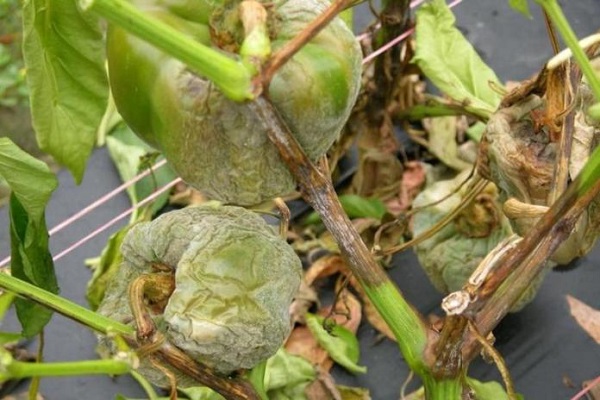Almost every garden grows pepper with other popular vegetables. Despite the abundant fruiting, there is a risk of reduction or loss of the crop due to damage by harmful microorganisms or diseases. Prevent a problem by arming yourself with knowledge that will help you recognize the first signs of disease. In this article we will learn why the leaves may fall off the peppers, who is to blame for this and what to do and how to deal with the scourge.
Table of contents
The main diseases of bell peppers and their treatment at home and in the greenhouse
When growing peppers, special attention is paid to preventive measures. Regular care and inspection of bushes is necessary for the timely detection of pests or diseases. Affected plants may die for 1-2 weeks if the cause is not identified in time and treatment is not made.. Abundant greenery and a moist environment create favorable conditions for the development of various diseases or insect invasions.
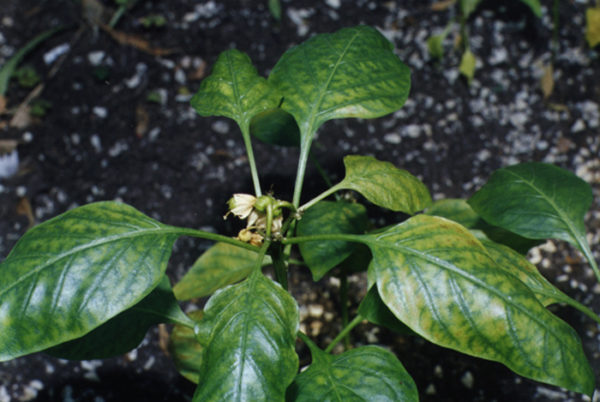
Blackleg
The fungal disease develops predominantly at the stage of shoot growth, therefore it is dangerous for seedlings and adult plants grown in greenhouse conditions.
The cause is pathogens of various species that are stored in the seeds, soil and crop residue. Too thick planting of seedlings and poor-quality aeration can provoke the formation of black legs, which is more often observed in greenhouses.
Signs characterizing the fungal disease:
- change the color of the lower part of the stem to brown;
- rotting in the darkened area;
- drying of the whole bush.
When detecting the first signs of a black leg, the following recommendations should be followed:
- at the very beginning of the development of the disease it is necessary to water the beds with a weak solution of potassium permanganate;
- gush up the ground around the bushes;
- spud pepper root collar;
- if the ground surface is too wet, you need to sprinkle the beds with river sand (ash, activated carbon);
- if the disease has hit the seedlings, you should ventilate the room, reduce the amount of watering.
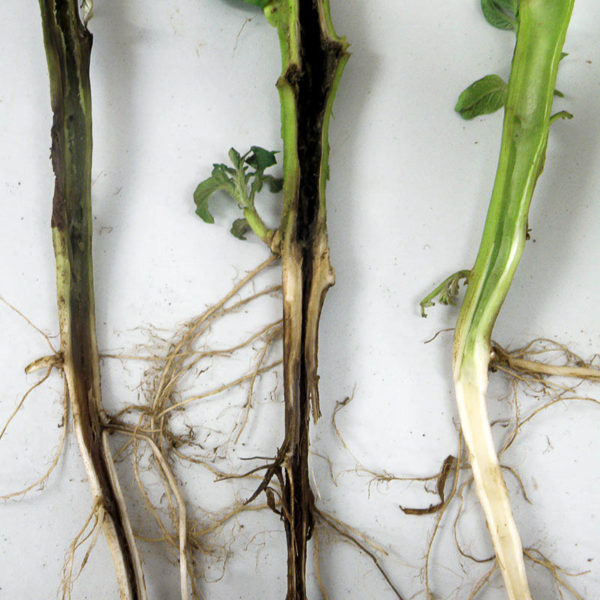
Gray rot
The disease is caused by the development of the fungus Botrytis cinerea. A characteristic feature is the formation of wet brown spots in the lower part of the stem, in the zone of its contact with the ground. After a short period of time, a grayish taint appears on the affected area. The active phase of the development of fungal disease occurs in conditions of high humidity in combination with air temperature above 20 ° C.
If during the inspection revealed the first signs of the disease, it is necessary to treat the beds with medical preparations:
- Fundazole;
- Acrobat Ordan;
- Soon;
- Previkur or others.
The affected plants should be removed from the plantation or transplanted into a separate container.
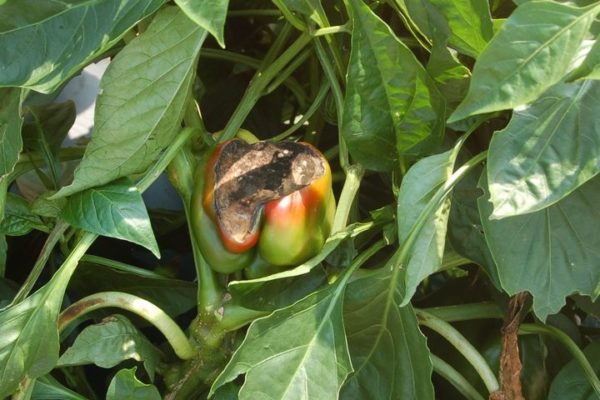
Lightning bacterial wilt
The pathogenic bacteria in lightning wilt penetrate the vascular system of the stem, thereby blocking the flow of nutrients. In addition to hunger, the plant is poisoned by toxic substances secreted by bacteria, which leads to the rapid death of the culture. A distinctive feature of the disease are yellowing spots on the foliage, indicating the drying of the plant, as well as the white substance secreted by incision of the stem.
If there are signs of wilting, it is recommended to remove the affected plant from the garden bed. The rest of the bushes to process special preparations containing copper.
Late blight
Refers to fungal diseases (fungus Phytophthora infestans), capable of destroying the crop of pepper. At an early stage of development, there are signs similar to the black leg. After 2 weeks, brown spots spread throughout the plant, including fruit. In dry weather, the leaves quickly dry out, shrink. The process of decay is accelerated at high humidity, so do not hesitate to process.
When identifying the first signs, you need to immediately do the processing of the beds using special preparations:
- Hamair (for irrigation - 1 tabl. Per 5 l of water, for spraying - 2 tablets per 1 l of water);
- Alirin-B (for irrigation - 2 tab. On a bucket of water, for spraying - 2 tab. On 1 l of water);
- Ridomil Gold (for spraying 10 g. Funds for 2 liters of water);
- Fitosporin-M (for spraying 10 g. Of powder per 5 liters of water).
On large plantations it is more rational to use more powerful drugs: Bravo, Quadris.
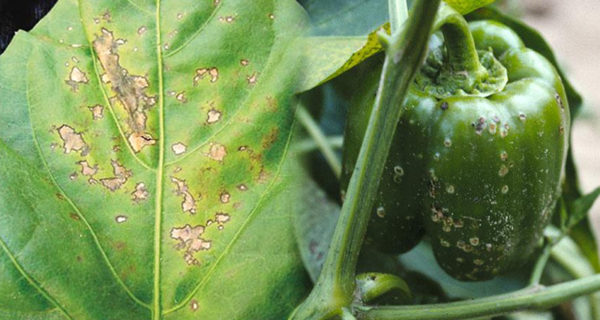
The defeat of pepper with kladosporiozom: why it occurs and how to spray?
The disease is caused by the development of the fungus Fulvia fulva, often affects greenhouse plants grown under conditions of high humidity. Brown spot is tolerated by spores that fall on the soil, garden tools, clothing, and greenhouse surfaces.
Signs of cladosporiosis:
- brown spots appeared on the outside of the leaves;
- a gray scurf with a velvety effect appears on the outside of the foliage;
- rotting of the stem and fruits.
If you find the first signs should immediately begin treatment:
- reduce the intensity of watering the beds;
- ensure good ventilation of the greenhouse;
- treat affected plants with special preparations (Barrier, Barrier).
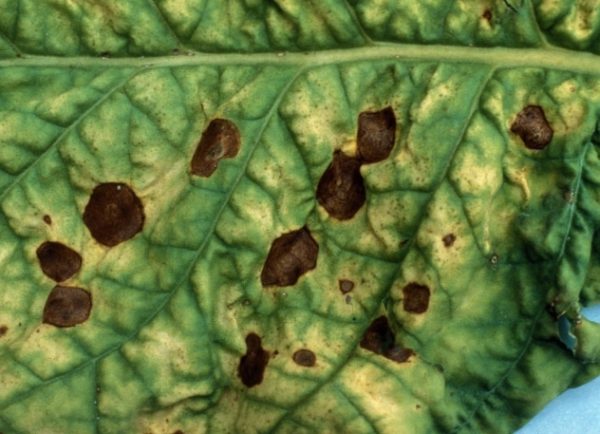
Fusarium and sclerocynia on the leaves of seedlings
The disease is caused by a fungus (Fusarium), which affects the stem vessels. As a result of the blockage of the ducts in the stem, the access of nutrients and moisture is blocked, the plant begins to die from toxin poisoning. An abundance of moisture (both in the air and in the soil) can provoke the development of a fungal disease.
Symptoms of the disease:
- leaves on pepper begin to curl, wither;
- even with good care greens turn yellow;
- the stem at the root part becomes brown;
- the development of rot on the roots, fruits.
Since Fusarium is an incurable disease, prevention plays an important role in the agricultural practices of pepper.
Preventive measures at home from Fusarium:
- before seeding the seed material, it is necessary to treat it with Fundazole (100 ml of product for 10 grams of seeds);
- periodically water the soil with a weak solution of potassium permanganate;
- after harvesting the beds, carefully select the crop residues.
When detecting the first signs of fusarium, it is recommended to treat the beds with Fundazole or Topsin-M (0.2%). Drugs are not able to overcome the disease, they only suspend the development process.
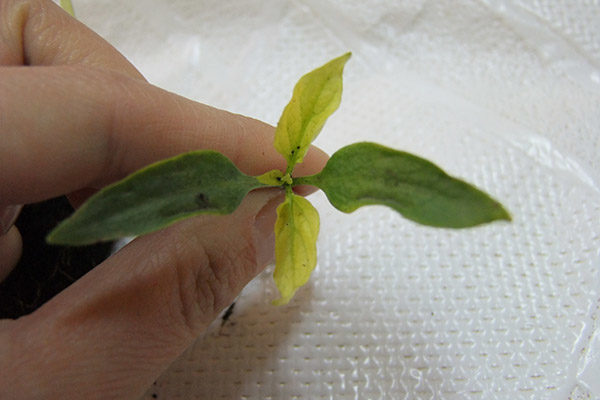
Disease black bacterial spotting
From the moment of emergence of seedlings above the ground, the plant can attack black bacterial spot. A characteristic sign of the disease are dark spots spreading along the stem and leaves. On the border with the green part you can see a yellow border.
Prevention is standard, including the correct choice of variety and the procedure for disinfecting soil and seed. It is hardly possible to save the affected plant, so it is important to immediately remove the diseased bushes to prevent the spread of the disease. The place of the excavation must be sanitized.
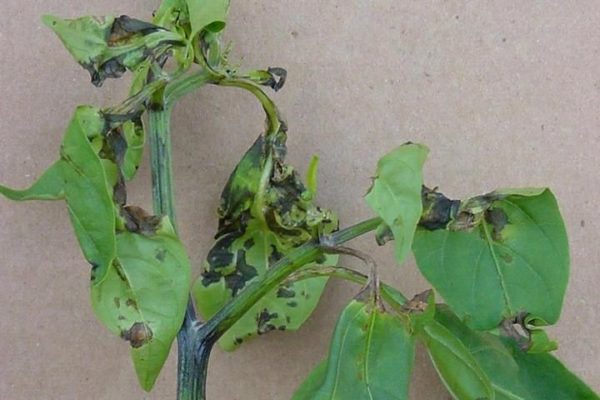
Bacterial pepper cancer and methods of dealing with it
The disease belongs to the bacterial, development is promoted by increased humidity and warm weather, as well as thickening of the beds. A characteristic feature is considered to be dark spots (dots) spreading across the plant, which subsequently merge with each other, forming a large crust. WITHThe front spots have a lighter color, which helps to determine the diagnosis. Small holes may appear.
If signs are detected, the culture should be sprayed with copper sulphate or preparations containing copper. Affected bushes should be removed from the bed.
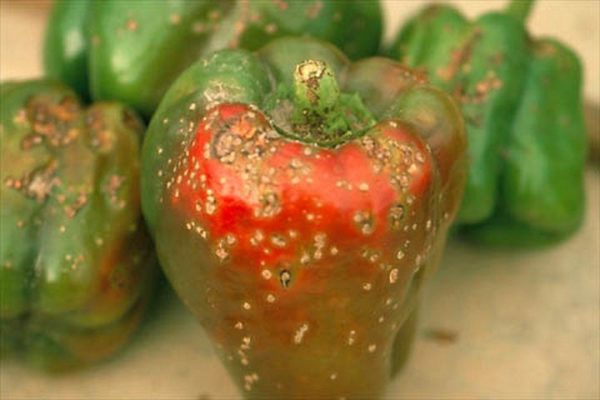
Fighting tobacco mosaic
Tobacco mosaic is a viral disease characterized by the penetration of the virus into cells and the destruction of chlorophyll.As a result of cell death, a marble pattern is formed on the surface of the sheet, with beige and emerald inclusions.
Disinfection of soil and seedlings before planting, as well as the right choice of variety, will help prevent the disease.
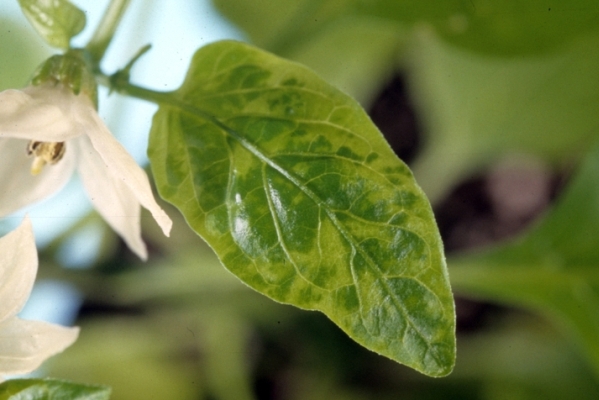
Pepper pests and how to deal with them
Destroy the crop may in addition to diseases and pests. One of the most dangerous is aphid. Feeding on the juice of pepper, it can destroy a bush in a few days, and leaves and flowers will begin to fall off. It spreads quickly on beds, so it’s not worth delaying with insecticide treatment. In order to keep the working solution prepared from Karbofos or Keltan longer on green, it is necessary to supplement it with crushed soap.
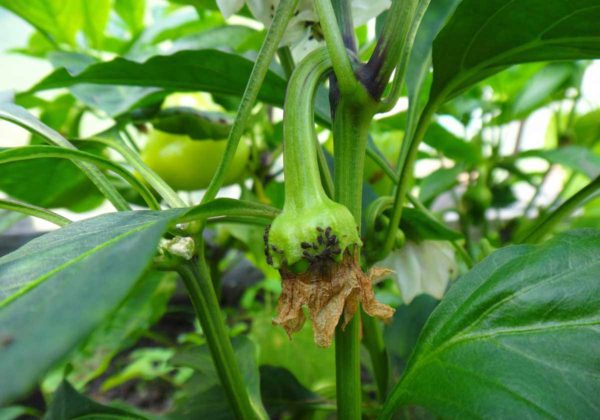
Greater hassle causes gardeners spider mite. Located on the lower part of the leaves, it sucks the juice from the pepper. Immediately after the parasite is detected, the beds need to be treated with an infusion prepared from a glass of chopped onion (garlic),dandelion leaves and 1 tbsp. l soap. All ingredients after adding a bucket of water insist for several hours.
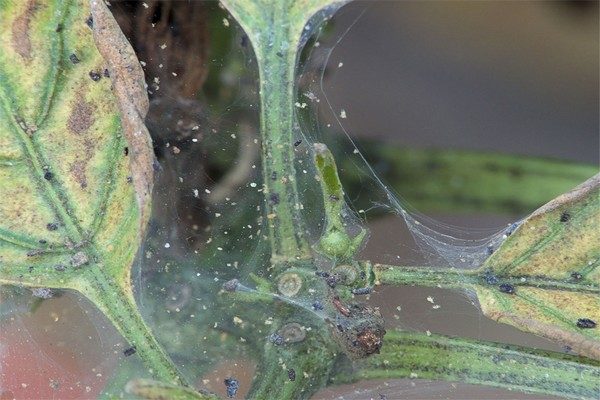
Among other pests pepper slugs are naked. They damage greens and fruits, causing decay. You can get rid of them by spraying the plants with Strela (50 grams of powder for a bucket of water).
Identified holes in the leaves indicate the invasion of the Colorado potato beetle. The pest and its larvae are incredibly voracious, so it is important not to lose time and collect insects from the bushes. After collecting, spray pepper with Commodore (1 ml per bucket of water).
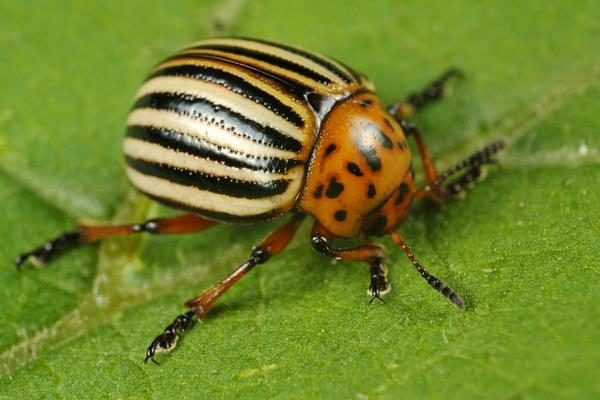
Enjoy the leaves loves and bear. Arranging traps and spraying the smell of kerosene in places of its accumulation helps in fighting it.
Pepper treatment for pests and diseases of folk remedies at home
To avoid problems when growing Bulgarian pepper, you can, if you follow the basic rules of prevention at home.
- When choosing a seed or seedling, preference should be given to disease resistant varieties.
- It is recommended to store seeds in the dry aired room.
- Before planting, the soil should be treated in order to destroy various pathogens and larvae.
- Before planting, seeds are soaked in a solution of copper sulfate, a weak solution of potassium permanganate or special preparations.
- Every day you need to inspect the beds in order to early identify foci. If necessary, spray or treat plants selected folk methods.
- Seedlings should be planted with a distance to avoid thickening.
- When watering to monitor the level of soil moisture. Excessive moisture provokes the development of fungal diseases.
Armed with knowledge gardeners easier to protect the crop from pests and diseases. One has only to comply with the systematic care of the culture. And then healthy bushes will grow even on the windowsill in the apartment.
